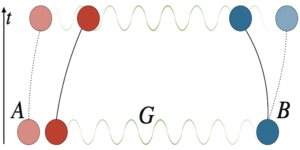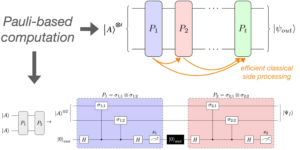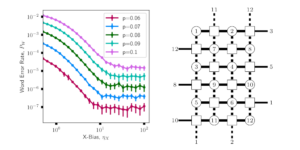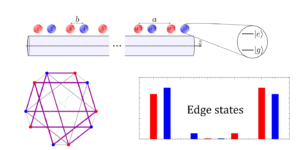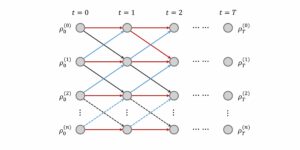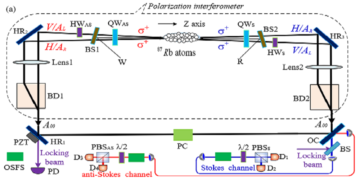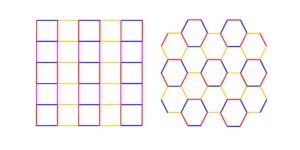1Institute for Quantum Optics and Quantum Information (IQOQI), Austrian Academy of Sciences, Boltzmanngasse 3, 1090 Vienna, Austria
2Faculty of Physics, University of Vienna, Boltzmanngasse 5, 1090 Vienna, Austria
3School of Physics, Trinity College Dublin, Dublin 2, Ireland
4Vienna Center for Quantum Science and Technology, Atominstitut, TU Wien, 1020 Vienna, Austria
5Department of Physics ``E. Fermi'' University of Pisa, Largo B. Pontecorvo 3, 56127 Pisa, Italy
Find this paper interesting or want to discuss? Scite or leave a comment on SciRate.
Abstract
We introduce a framework to compute upper bounds for temporal correlations achievable in open quantum system dynamics, obtained by repeated measurements on the system. As these correlations arise by virtue of the environment acting as a memory resource, such bounds are witnesses for the minimal dimension of an effective environment compatible with the observed statistics. These witnesses are derived from a hierarchy of semidefinite programs with guaranteed asymptotic convergence. We compute non-trivial bounds for various sequences involving a qubit system and a qubit environment, and compare the results to the best known quantum strategies producing the same outcome sequences. Our results provide a numerically tractable method to determine bounds on multi-time probability distributions in open quantum system dynamics and allow for the witnessing of effective environment dimensions through probing of the system alone.
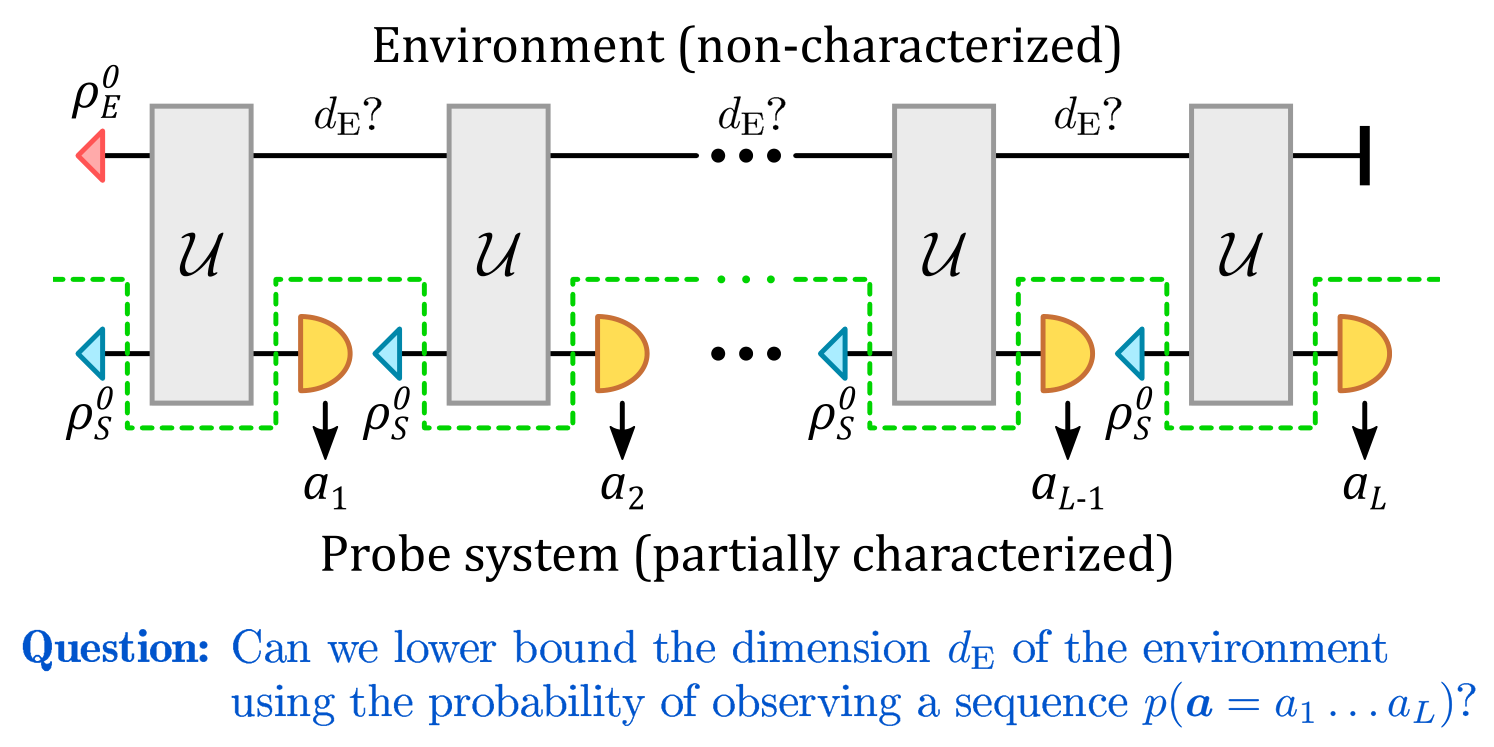
Featured image: The sequential measurement protocol used in this work. It involves a partially characterized probe system and a non-characterized environment, here separated by the dashed line. The sequence of measurement outcomes $mathbf{a} = a_1 a_2 dots a_L$ is obtained by repeated preparations of a probe state $ρ_S^0$, fixed and the same at every time step, which is left to interact with the environment, then followed by measurements (semicircles). The environment acts as a memory resource, capable of establishing long-term correlations between measurements.
Popular summary
A natural question arises: what is the minimum dimension a system must have in order for it to produce some observed behavior? This question can be answered with the concept of a "dimension witness": an inequality which, when violated, certifies this minimum dimension.
In this work, we investigate an application of this idea to the behavior of open quantum systems.
Physical systems are never completely isolated, and inevitably interact with their surrounding environment. As a result, information in the system can leak away into the environment at one moment, only to be partially recovered later. Therefore, the environment can act as an additional memory resource, resulting in complex correlations in time.
Even thought, in practice, the environment may be very large in size, only a small portion of it may effectively act as a memory. By establishing upper bounds on the temporal correlations achievable by repeated preparations and measurements on a small "probe" quantum system interacting with an environment of fixed size, we can construct a dimension witness for the minimum size of its effective environment.
This work provides a practical technique to obtain such bounds on temporal correlations. Our results show that there is a wealth of information contained in temporal correlations, highlighting their potential in new techniques for characterizing large complex systems by means of a small probe alone.
► BibTeX data
► References
[1] L. Accardi, A. Frigerio, and J. T. Lewis. Quantum Stochastic Processes. Publ. Rest. Inst. Math. Sci., 18: 97–133, 1982. 10.2977/prims/1195184017.
https://doi.org/10.2977/prims/1195184017
[2] Akshay Agrawal, Robin Verschueren, Steven Diamond, and Stephen Boyd. A rewriting system for convex optimization problems. J. Control. Decis, 5 (1): 42–60, 2018. 10.1080/23307706.2017.1397554.
https://doi.org/10.1080/23307706.2017.1397554
[3] S. Alipour, M. Mehboudi, and A. T. Rezakhani. Quantum metrology in open systems: Dissipative cramér-rao bound. Phys. Rev. Lett., 112: 120405, Mar 2014. 10.1103/PhysRevLett.112.120405.
https://doi.org/10.1103/PhysRevLett.112.120405
[4] Mario Berta, Francesco Borderi, Omar Fawzi, and Volkher B Scholz. Semidefinite programming hierarchies for constrained bilinear optimization. Math. Program., 194: 781–829, 2022. 10.1007/s10107-021-01650-1.
https://doi.org/10.1007/s10107-021-01650-1
[5] Stephen Boyd and Lieven Vandenberghe. Convex optimization. Cambridge university press, 2004. ISBN 9780521833783. 10.1017/CBO9780511804441. URL https://web.stanford.edu/ boyd/cvxbook/.
https://doi.org/10.1017/CBO9780511804441
https://web.stanford.edu/~boyd/cvxbook/
[6] V. B. Braginsky and F. Y. Khalili. Quantum Measurement. Cambridge University Press, 1992. 10.1017/CBO9780511622748.
https://doi.org/10.1017/CBO9780511622748
[7] Heinz-Peter Breuer and Francesco Petruccione. The Theory of Open Quantum Systems. Oxford University Press, 2002. ISBN 978-0-198-52063-4. 10.1093/acprof:oso/9780199213900.001.0001.
https://doi.org/10.1093/acprof:oso/9780199213900.001.0001
[8] Heinz-Peter Breuer, Elsi-Mari Laine, Jyrki Piilo, and Bassano Vacchini. Colloquium: Non-markovian dynamics in open quantum systems. Rev. Mod. Phys., 88: 021002, Apr 2016. 10.1103/RevModPhys.88.021002.
https://doi.org/10.1103/RevModPhys.88.021002
[9] Nicolas Brunner, Miguel Navascués, and Tamás Vértesi. Dimension witnesses and quantum state discrimination. Phys. Rev. Lett., 110: 150501, Apr 2013. 10.1103/PhysRevLett.110.150501.
https://doi.org/10.1103/PhysRevLett.110.150501
[10] Adrián A. Budini. Embedding non-Markovian quantum collisional models into bipartite Markovian dynamics. Phys. Rev. A, 88 (3): 032115, September 2013. 10.1103/PhysRevA.88.032115.
https://doi.org/10.1103/PhysRevA.88.032115
[11] Costantino Budroni and Clive Emary. Temporal quantum correlations and Leggett-Garg inequalities in multilevel systems. Phys. Rev. Lett., 113: 050401, Jul 2014. 10.1103/PhysRevLett.113.050401.
https://doi.org/10.1103/PhysRevLett.113.050401
[12] Costantino Budroni, Gabriel Fagundes, and Matthias Kleinmann. Memory cost of temporal correlations. New J. Phys., 21 (9): 093018, sep 2019. 10.1088/1367-2630/ab3cb4.
https://doi.org/10.1088/1367-2630/ab3cb4
[13] Costantino Budroni, Giuseppe Vitagliano, and Mischa P Woods. Ticking-clock performance enhanced by nonclassical temporal correlations. Phys. Rev. Research, 3 (3): 033051, 2021. 10.1103/PhysRevResearch.3.033051.
https://doi.org/10.1103/PhysRevResearch.3.033051
[14] Paul Busch, Pekka J. Lahti, and Peter Mittelstaedt. The Quantum Theory of Measurement, volume 2 of Lecture Notes in Physics Monographs. Springer-Verlag Berlin Heidelberg, 2 edition, 1996. 10.1007/978-3-540-37205-9.
https://doi.org/10.1007/978-3-540-37205-9
[15] Carlton M. Caves, Christopher A. Fuchs, and Rüdiger Schack. Unknown quantum states: The quantum de Finetti representation. J. Math. Phys., 43 (9): 4537–4559, 2002. 10.1063/1.1494475.
https://doi.org/10.1063/1.1494475
[16] Giulio Chiribella. On quantum estimation, quantum cloning and finite quantum de finetti theorems. In Wim van Dam, Vivien M. Kendon, and Simone Severini, editors, Theory of Quantum Computation, Communication, and Cryptography, pages 9–25, Berlin, Heidelberg, 2011. Springer Berlin Heidelberg. 10.1007/978-3-642-18073-6_2.
https://doi.org/10.1007/978-3-642-18073-6_2
[17] Giulio Chiribella, Giacomo Mauro D'Ariano, and Paolo Perinotti. Theoretical framework for quantum networks. Phys. Rev. A, 80: 022339, Aug 2009. 10.1103/PhysRevA.80.022339.
https://doi.org/10.1103/PhysRevA.80.022339
[18] Giulio Chiribella, Giacomo Mauro D'Ariano, Paolo Perinotti, and Benoit Valiron. Quantum computations without definite causal structure. Phys. Rev. A, 88: 022318, Aug 2013. 10.1103/PhysRevA.88.022318.
https://doi.org/10.1103/PhysRevA.88.022318
[19] Man-Duen Choi. Completely positive linear maps on complex matrices. Linear Algebra Its Appl., 10 (3): 285–290, 1975. ISSN 0024-3795. 10.1016/0024-3795(75)90075-0.
https://doi.org/10.1016/0024-3795(75)90075-0
[20] Matthias Christandl, Robert König, Graeme Mitchison, and Renato Renner. One-and-a-half quantum de Finetti theorems. Commun. Math. Phys., 273 (2): 473–498, 2007. 10.1007/s00220-007-0189-3.
https://doi.org/10.1007/s00220-007-0189-3
[21] Luis A. Correa, Mohammad Mehboudi, Gerardo Adesso, and Anna Sanpera. Individual quantum probes for optimal thermometry. Phys. Rev. Lett., 114: 220405, Jun 2015. 10.1103/PhysRevLett.114.220405.
https://doi.org/10.1103/PhysRevLett.114.220405
[22] C. L. Degen, F. Reinhard, and P. Cappellaro. Quantum sensing. Rev. Mod. Phys., 89: 035002, Jul 2017. 10.1103/RevModPhys.89.035002.
https://doi.org/10.1103/RevModPhys.89.035002
[23] Steven Diamond and Stephen Boyd. CVXPY: A Python-embedded modeling language for convex optimization. J. Mach. Learn. Res, 17 (83): 1–5, 2016. 10.5555/2946645.3007036. URL https://dl.acm.org/doi/10.5555/2946645.3007036.
https://doi.org/10.5555/2946645.3007036
[24] A. C. Doherty, Pablo A. Parrilo, and Federico M. Spedalieri. Distinguishing separable and entangled states. Phys. Rev. Lett., 88: 187904, Apr 2002. 10.1103/PhysRevLett.88.187904.
https://doi.org/10.1103/PhysRevLett.88.187904
[25] Andrew C. Doherty, Pablo A. Parrilo, and Federico M. Spedalieri. Complete family of separability criteria. Phys. Rev. A, 69: 022308, Feb 2004. 10.1103/PhysRevA.69.022308.
https://doi.org/10.1103/PhysRevA.69.022308
[26] Clive Emary, Neill Lambert, and Franco Nori. Leggett–Garg inequalities. Rep. Prog. Phys., 77 (1): 016001, dec 2013. ISSN 0034-4885. 10.1088/0034-4885/77/1/016001.
https://doi.org/10.1088/0034-4885/77/1/016001
[27] Tobias Fritz. Quantum correlations in the temporal Clauser–Horne–Shimony–Holt (CHSH) scenario. New J. Phys., 12 (8): 083055, 2010. 10.1088/1367-2630/12/8/083055.
https://doi.org/10.1088/1367-2630/12/8/083055
[28] Mituhiro Fukuda, Masakazu Kojima, Kazuo Murota, and Kazuhide Nakata. Exploiting sparsity in semidefinite programming via matrix completion I: General framework. SIAM J. Optim., 11 (3): 647–674, 2001. 10.1137/S1052623400366218.
https://doi.org/10.1137/S1052623400366218
[29] Rodrigo Gallego, Nicolas Brunner, Christopher Hadley, and Antonio Acín. Device-independent tests of classical and quantum dimensions. Phys. Rev. Lett., 105: 230501, Nov 2010. 10.1103/PhysRevLett.105.230501.
https://doi.org/10.1103/PhysRevLett.105.230501
[30] Christina Giarmatzi and Fabio Costa. Witnessing quantum memory in non-Markovian processes. Quantum, 5: 440, April 2021. ISSN 2521-327X. 10.22331/q-2021-04-26-440.
https://doi.org/10.22331/q-2021-04-26-440
[31] Otfried Gühne, Costantino Budroni, Adán Cabello, Matthias Kleinmann, and Jan-Åke Larsson. Bounding the quantum dimension with contextuality. Phys. Rev. A, 89: 062107, Jun 2014. 10.1103/PhysRevA.89.062107.
https://doi.org/10.1103/PhysRevA.89.062107
[32] Leonid Gurvits. Classical deterministic complexity of edmonds' problem and quantum entanglement. In Proceedings of the Thirty-Fifth Annual ACM Symposium on Theory of Computing, STOC '03, page 10–19, New York, NY, USA, 2003. Association for Computing Machinery. ISBN 1581136749. 10.1145/780542.780545.
https://doi.org/10.1145/780542.780545
[33] Otfried Gühne and Géza Tóth. Entanglement detection. Phys. Rep., 474 (1): 1–75, 2009. ISSN 0370-1573. 10.1016/j.physrep.2009.02.004.
https://doi.org/10.1016/j.physrep.2009.02.004
[34] Aram W Harrow. The church of the symmetric subspace. arXiv:1308.6595, 2013. URL https://arxiv.org/abs/1308.6595.
arXiv:1308.6595
[35] Jannik Hoffmann, Cornelia Spee, Otfried Gühne, and Costantino Budroni. Structure of temporal correlations of a qubit. New J. Phys., 20 (10): 102001, oct 2018. 10.1088/1367-2630/aae87f.
https://doi.org/10.1088/1367-2630/aae87f
[36] Michał Horodecki, Paweł Horodecki, and Ryszard Horodecki. Mixed-state entanglement and distillation: Is there a ``bound'' entanglement in Nature? Phys. Rev. Lett, 80: 5239–5242, Jun 1998. 10.1103/PhysRevLett.80.5239.
https://doi.org/10.1103/PhysRevLett.80.5239
[37] A. Jamiołkowski. Linear transformations which preserve trace and positive semidefiniteness of operators. Rep. Math. Phys., 3 (4): 275–278, 1972. ISSN 0034-4877. 10.1016/0034-4877(72)90011-0.
https://doi.org/10.1016/0034-4877(72)90011-0
[38] Hyejung H. Jee, Carlo Sparaciari, Omar Fawzi, and Mario Berta. Quasi-Polynomial Time Algorithms for Free Quantum Games in Bounded Dimension. In Nikhil Bansal, Emanuela Merelli, and James Worrell, editors, 48th International Colloquium on Automata, Languages, and Programming (ICALP 2021), volume 198 of Leibniz International Proceedings in Informatics (LIPIcs), pages 82:1–82:20, Dagstuhl, Germany, 2021. Schloss Dagstuhl – Leibniz-Zentrum für Informatik. ISBN 978-3-95977-195-5. 10.4230/LIPIcs.ICALP.2021.82.
https://doi.org/10.4230/LIPIcs.ICALP.2021.82
[39] J. K. Korbicz, J. I. Cirac, and M. Lewenstein. Spin squeezing inequalities and entanglement of $n$ qubit states. Phys. Rev. Lett., 95: 120502, Sep 2005. 10.1103/PhysRevLett.95.120502.
https://doi.org/10.1103/PhysRevLett.95.120502
[40] A. J. Leggett. Realism and the physical world. Rep. Prog. Phys., 71 (2): 022001, jan 2008. ISSN 0034-4885. 10.1088/0034-4885/71/2/022001.
https://doi.org/10.1088/0034-4885/71/2/022001
[41] A. J. Leggett and Anupam Garg. Quantum mechanics versus macroscopic realism: Is the flux there when nobody looks? Phys. Rev. Lett., 54 (9): 857–860, mar 1985. 10.1103/PhysRevLett.54.857.
https://doi.org/10.1103/PhysRevLett.54.857
[42] Göran Lindblad. Non-Markovian quantum stochastic processes and their entropy. Comm. Math. Phys., 65 (3): 281–294, 1979. 10.1007/BF01197883.
https://doi.org/10.1007/BF01197883
[43] I. A. Luchnikov, S. V. Vintskevich, and S. N. Filippov. Dimension truncation for open quantum systems in terms of tensor networks, jan 2018. URL http://arxiv.org/abs/1801.07418. arXiv:1801.07418.
arXiv:1801.07418
[44] I. A. Luchnikov, S. V. Vintskevich, H. Ouerdane, and S. N. Filippov. Simulation Complexity of Open Quantum Dynamics: Connection with Tensor Networks. Phys. Rev. Lett., 122 (16): 160401, apr 2019. 10.1103/PhysRevLett.122.160401.
https://doi.org/10.1103/PhysRevLett.122.160401
[45] I. A. Luchnikov, E. O. Kiktenko, M. A. Gavreev, H. Ouerdane, S. N. Filippov, and A. K. Fedorov. Probing non-Markovian quantum dynamics with data-driven analysis: Beyond ``black-box'' machine-learning models. Phys. Rev. Res., 4 (4): 043002, October 2022. 10.1103/PhysRevResearch.4.043002.
https://doi.org/10.1103/PhysRevResearch.4.043002
[46] Yuanyuan Mao, Cornelia Spee, Zhen-Peng Xu, and Otfried Gühne. Structure of dimension-bounded temporal correlations. Phys. Rev. A, 105: L020201, Feb 2022. 10.1103/PhysRevA.105.L020201.
https://doi.org/10.1103/PhysRevA.105.L020201
[47] Mohammad Mehboudi, Anna Sanpera, and Luis A Correa. Thermometry in the quantum regime: recent theoretical progress. Journal of Physics A: Mathematical and Theoretical, 52 (30): 303001, jul 2019. 10.1088/1751-8121/ab2828.
https://doi.org/10.1088/1751-8121/ab2828
[48] Simon Milz and Kavan Modi. Quantum stochastic processes and quantum non-Markovian phenomena. PRX Quantum, 2: 030201, Jul 2021. 10.1103/PRXQuantum.2.030201.
https://doi.org/10.1103/PRXQuantum.2.030201
[49] Miguel Navascués, Masaki Owari, and Martin B. Plenio. Power of symmetric extensions for entanglement detection. Phys. Rev. A, 80: 052306, Nov 2009. 10.1103/PhysRevA.80.052306.
https://doi.org/10.1103/PhysRevA.80.052306
[50] Brendan O'Donoghue, Eric Chu, Neal Parikh, and Stephen Boyd. Conic optimization via operator splitting and homogeneous self-dual embedding. J. Optim. Theory Appl, 169 (3): 1042–1068, June 2016. 10.1007/s10957-016-0892-3.
https://doi.org/10.1007/s10957-016-0892-3
[51] Brendan O'Donoghue, Eric Chu, Neal Parikh, and Stephen Boyd. SCS: Splitting Conic Solver, version 3.2.2. https://github.com/cvxgrp/scs, November 2022.
https://github.com/cvxgrp/scs
[52] Ognyan Oreshkov, Fabio Costa, and Časlav Brukner. Quantum correlations with no causal order. Nat. Commun., 3 (1): 1092, Oct 2012. 10.1038/ncomms2076.
https://doi.org/10.1038/ncomms2076
[53] Asher Peres. Separability criterion for density matrices. Phys. Rev. Lett., 77: 1413–1415, Aug 1996. 10.1103/PhysRevLett.77.1413.
https://doi.org/10.1103/PhysRevLett.77.1413
[54] Felix A. Pollock, César Rodríguez-Rosario, Thomas Frauenheim, Mauro Paternostro, and Kavan Modi. Non-Markovian quantum processes: Complete framework and efficient characterization. Phys. Rev. A, 97: 012127, Jan 2018. 10.1103/PhysRevA.97.012127.
https://doi.org/10.1103/PhysRevA.97.012127
[55] Ángel Rivas and Susana F Huelga. Open Quantum Systems: An Introduction. Springer Berlin, Heidelberg, 2011. ISBN 978-3-642-23353-1. 10.1007/978-3-642-23354-8.
https://doi.org/10.1007/978-3-642-23354-8
[56] Ángel Rivas, Susana F Huelga, and Martin B Plenio. Quantum non-markovianity: characterization, quantification and detection. Rep. Prog. Phys., 77 (9): 094001, aug 2014. 10.1088/0034-4885/77/9/094001.
https://doi.org/10.1088/0034-4885/77/9/094001
[57] Carlos Sabín, Angela White, Lucia Hackermuller, and Ivette Fuentes. Impurities as a quantum thermometer for a Bose-Einstein condensate. Sci. Rep., 4 (1): 1–6, 2014. 10.1038/srep06436.
https://doi.org/10.1038/srep06436
[58] Greg Schild and Clive Emary. Maximum violations of the quantum-witness equality. Phys. Rev. A, 92: 032101, Sep 2015. 10.1103/PhysRevA.92.032101.
https://doi.org/10.1103/PhysRevA.92.032101
[59] Paul Skrzypczyk and Daniel Cavalcanti. Semidefinite Programming in Quantum Information Science. 2053-2563. IOP Publishing, 2023. ISBN 978-0-7503-3343-6. 10.1088/978-0-7503-3343-6.
https://doi.org/10.1088/978-0-7503-3343-6
[60] Adel Sohbi, Damian Markham, Jaewan Kim, and Marco Túlio Quintino. Certifying dimension of quantum systems by sequential projective measurements. Quantum, 5: 472, June 2021. ISSN 2521-327X. 10.22331/q-2021-06-10-472.
https://doi.org/10.22331/q-2021-06-10-472
[61] Cornelia Spee, Costantino Budroni, and Otfried Gühne. Simulating extremal temporal correlations. New J. Phys., 22 (10): 103037, oct 2020. 10.1088/1367-2630/abb899.
https://doi.org/10.1088/1367-2630/abb899
[62] John K. Stockton, J. M. Geremia, Andrew C. Doherty, and Hideo Mabuchi. Characterizing the entanglement of symmetric many-particle spin-$frac{1}{2}$ systems. Phys. Rev. A, 67: 022112, Feb 2003. 10.1103/PhysRevA.67.022112.
https://doi.org/10.1103/PhysRevA.67.022112
[63] D. Tamascelli, A. Smirne, S. F. Huelga, and M. B. Plenio. Nonperturbative Treatment of non-Markovian Dynamics of Open Quantum Systems. Phys. Rev. Lett., 120 (3): 030402, January 2018. 10.1103/PhysRevLett.120.030402.
https://doi.org/10.1103/PhysRevLett.120.030402
[64] Armin Tavakoli, Alejandro Pozas-Kerstjens, Peter Brown, and Mateus Araújo. Semidefinite programming relaxations for quantum correlations. 2023. URL https://arxiv.org/abs/2307.02551.
arXiv:2307.02551
[65] Barbara M. Terhal. Bell inequalities and the separability criterion. Phys. Lett. A, 271 (5): 319–326, 2000. ISSN 0375-9601. 10.1016/S0375-9601(00)00401-1.
https://doi.org/10.1016/S0375-9601(00)00401-1
[66] Géza Tóth, Tobias Moroder, and Otfried Gühne. Evaluating convex roof entanglement measures. Phys. Rev. Lett., 114: 160501, Apr 2015. 10.1103/PhysRevLett.114.160501.
https://doi.org/10.1103/PhysRevLett.114.160501
[67] Lucas B. Vieira and Costantino Budroni. Temporal correlations in the simplest measurement sequences. Quantum, 6: 623, 2022. 10.22331/q-2022-01-18-623.
https://doi.org/10.22331/q-2022-01-18-623
[68] Giuseppe Vitagliano and Costantino Budroni. Leggett-garg macrorealism and temporal correlations. Phys. Rev. A, 107: 040101, Apr 2023. 10.1103/PhysRevA.107.040101.
https://doi.org/10.1103/PhysRevA.107.040101
[69] John Watrous. The Theory of Quantum Information. Cambridge University Press, 2018. 10.1017/9781316848142.
https://doi.org/10.1017/9781316848142
[70] Henry Wolkowicz, Romesh Saigal, and Lieven Vandenberghe. Handbook of semidefinite programming: theory, algorithms, and applications, volume 27. Springer Science & Business Media, 2012. 10.1007/978-1-4615-4381-7.
https://doi.org/10.1007/978-1-4615-4381-7
[71] Shibei Xue, Matthew R. James, Alireza Shabani, Valery Ugrinovskii, and Ian R. Petersen. Quantum filter for a class of non-Markovian quantum systems. In 54th IEEE Conference on Decision and Control (CDC), pages 7096–7100, December 2015. 10.1109/CDC.2015.7403338.
https://doi.org/10.1109/CDC.2015.7403338
[72] Shibei Xue, Thien Nguyen, Matthew R. James, Alireza Shabani, Valery Ugrinovskii, and Ian R. Petersen. Modeling for Non-Markovian Quantum Systems. IEEE Trans. Control Syst. Technol., 28 (6): 2564–2571, November 2020. ISSN 1558-0865. 10.1109/TCST.2019.2935421.
https://doi.org/10.1109/TCST.2019.2935421
[73] Xiao-Dong Yu, Timo Simnacher, H. Chau Nguyen, and Otfried Gühne. Quantum-inspired hierarchy for rank-constrained optimization. PRX Quantum, 3: 010340, Mar 2022. 10.1103/PRXQuantum.3.010340.
https://doi.org/10.1103/PRXQuantum.3.010340
[74] Yang Zheng, Giovanni Fantuzzi, and Antonis Papachristodoulou. Chordal and factor-width decompositions for scalable semidefinite and polynomial optimization. Annu. Rev. Control, 52: 243–279, 2021. ISSN 1367-5788. 10.1016/j.arcontrol.2021.09.001.
https://doi.org/10.1016/j.arcontrol.2021.09.001
Cited by
This Paper is published in Quantum under the Creative Commons Attribution 4.0 International (CC BY 4.0) license. Copyright remains with the original copyright holders such as the authors or their institutions.
- SEO Powered Content & PR Distribution. Get Amplified Today.
- PlatoData.Network Vertical Generative Ai. Empower Yourself. Access Here.
- PlatoAiStream. Web3 Intelligence. Knowledge Amplified. Access Here.
- PlatoESG. Carbon, CleanTech, Energy, Environment, Solar, Waste Management. Access Here.
- PlatoHealth. Biotech and Clinical Trials Intelligence. Access Here.
- Source: https://quantum-journal.org/papers/q-2024-01-10-1224/
- :is
- ][p
- 001
- 09
- 1
- 10
- 107
- 11
- 110
- 114
- 12
- 120
- 13
- 14
- 15%
- 16
- 17
- 19
- 1985
- 1996
- 1998
- 20
- 2000
- 2001
- 2005
- 2008
- 2010
- 2011
- 2012
- 2013
- 2014
- 2015
- 2016
- 2017
- 2018
- 2019
- 2020
- 2021
- 2022
- 2023
- 22
- 23
- 24
- 25
- 26
- 27
- 28
- 29
- 30
- 31
- 32
- 33
- 35%
- 36
- 39
- 40
- 41
- 43
- 46
- 49
- 50
- 51
- 52
- 53
- 54
- 58
- 60
- 65
- 66
- 67
- 7
- 70
- 72
- 73
- 75
- 77
- 8
- 80
- 9
- 97
- a
- ABSTRACT
- Academy
- access
- achievable
- ACM
- Act
- acting
- acts
- Additional
- affiliations
- algorithms
- alireza
- allow
- alone
- amount
- an
- analysis
- and
- Andrew
- anna
- annual
- Application
- applications
- apr
- April
- ARE
- arise
- AS
- asher
- Association
- At
- Aug
- austrian
- author
- authors
- away
- b
- BE
- behavior
- Bell
- berlin
- BEST
- between
- Beyond
- bound
- bounds
- Break
- brown
- busch
- business
- by
- cambridge
- CAN
- capable
- carlos
- CDC
- Center
- certifies
- characterized
- Christopher
- church
- class
- College
- comm
- comment
- Commons
- Communication
- compare
- compatible
- complete
- completely
- completion
- complex
- complexity
- computation
- computations
- Compute
- computing
- concept
- Conference
- connection
- consequence
- constraints
- construct
- contained
- control
- Convergence
- Convex
- copyright
- Cornelia
- correlations
- Cost
- costa
- criteria
- cryptography
- Daniel
- data-driven
- de
- dec
- December
- decision
- degen
- Den
- density
- Derived
- Detection
- Determine
- Diamond
- Dimension
- dimensions
- Discrimination
- discuss
- Display
- distributions
- dublin
- dynamics
- e
- edition
- editors
- Effective
- effectively
- efficient
- embedding
- enhanced
- Environment
- equality
- eric
- establishing
- Ether (ETH)
- evaluating
- Every
- extensions
- family
- Feb
- Federico
- filter
- fixed
- FLUX
- followed
- For
- Framework
- Free
- free quantum games
- from
- fundamental
- future
- Games
- garg
- General
- Germany
- guaranteed
- Have
- henry
- here
- hierarchy
- highlighting
- holders
- How
- http
- HTTPS
- i
- idea
- IEEE
- image
- in
- individual
- inequalities
- Inequality
- inevitably
- influence
- information
- institutions
- interact
- interacting
- interesting
- International
- into
- introduce
- Introduction
- investigate
- involves
- involving
- isolated
- IT
- ITS
- james
- Jan
- January
- JavaScript
- John
- journal
- june
- Kim
- known
- kojima
- König
- language
- Languages
- large
- later
- leak
- LEARN
- Leave
- Lecture
- left
- Lewis
- License
- Line
- long-term
- LOOKS
- machinery
- Maps
- Marco
- Mario
- Martin
- math
- mathematical
- Matrix
- matthew
- matthias
- max-width
- maximum
- May..
- means
- measurement
- measurements
- measures
- mechanics
- Media
- Memory
- method
- Metrology
- minimal
- minimum
- modeling
- models
- moment
- Month
- much
- must
- Natural
- Nature
- networks
- never
- New
- New York
- Nguyen
- Nicolas
- no
- Notes
- nov
- November
- number
- NY
- observed
- obtain
- obtained
- Oct
- october
- of
- omar
- on
- ONE
- only
- open
- operator
- operators
- optics
- optimal
- optimization
- or
- order
- original
- our
- Outcome
- outcomes
- over
- Oxford
- oxford university
- pablo
- page
- pages
- Paolo
- Paper
- past
- Paul
- perfectly
- performance
- Peter
- physical
- Physics
- plato
- Plato Data Intelligence
- PlatoData
- portion
- positive
- potential
- power
- Practical
- practice
- press
- probability
- probe
- Problem
- problems
- Proceedings
- processes
- produce
- producing
- Program
- Programming
- Programs
- Progress
- protocol
- provide
- provides
- published
- publisher
- Publishing
- quantification
- quantifies
- Quantum
- quantum entanglement
- quantum games
- quantum information
- quantum measurement
- Quantum Mechanics
- quantum networks
- Quantum optics
- quantum systems
- Qubit
- question
- R
- recent
- references
- regime
- remains
- remember
- repeated
- representation
- research
- resource
- REST
- result
- resulting
- Results
- rewriting
- ROBERT
- Robin
- roof
- s
- same
- scalable
- scenario
- SCI
- Science
- Science and Technology
- SCIENCES
- sense
- September
- Sequence
- show
- siam
- Simon
- simulation
- Size
- small
- some
- Spin
- stanford
- State
- States
- statistics
- Step
- Stephen
- steven
- stored
- strategies
- structure
- such
- Surrounding
- Symposium
- system
- Systems
- T
- technique
- techniques
- Technology
- terms
- tests
- that
- The
- their
- then
- theoretical
- theory
- There.
- therefore
- These
- this
- thought
- Through
- time
- Timo
- Title
- to
- trace
- trans
- transformations
- treatment
- Trinity
- truncation
- under
- university
- unknown
- URL
- USA
- used
- various
- version
- Versus
- very
- via
- violated
- Violations
- volume
- W
- want
- we
- Wealth
- What
- What is
- when
- which
- white
- with
- without
- witness
- witnessing
- Woods
- Work
- world
- year
- york
- zephyrnet

